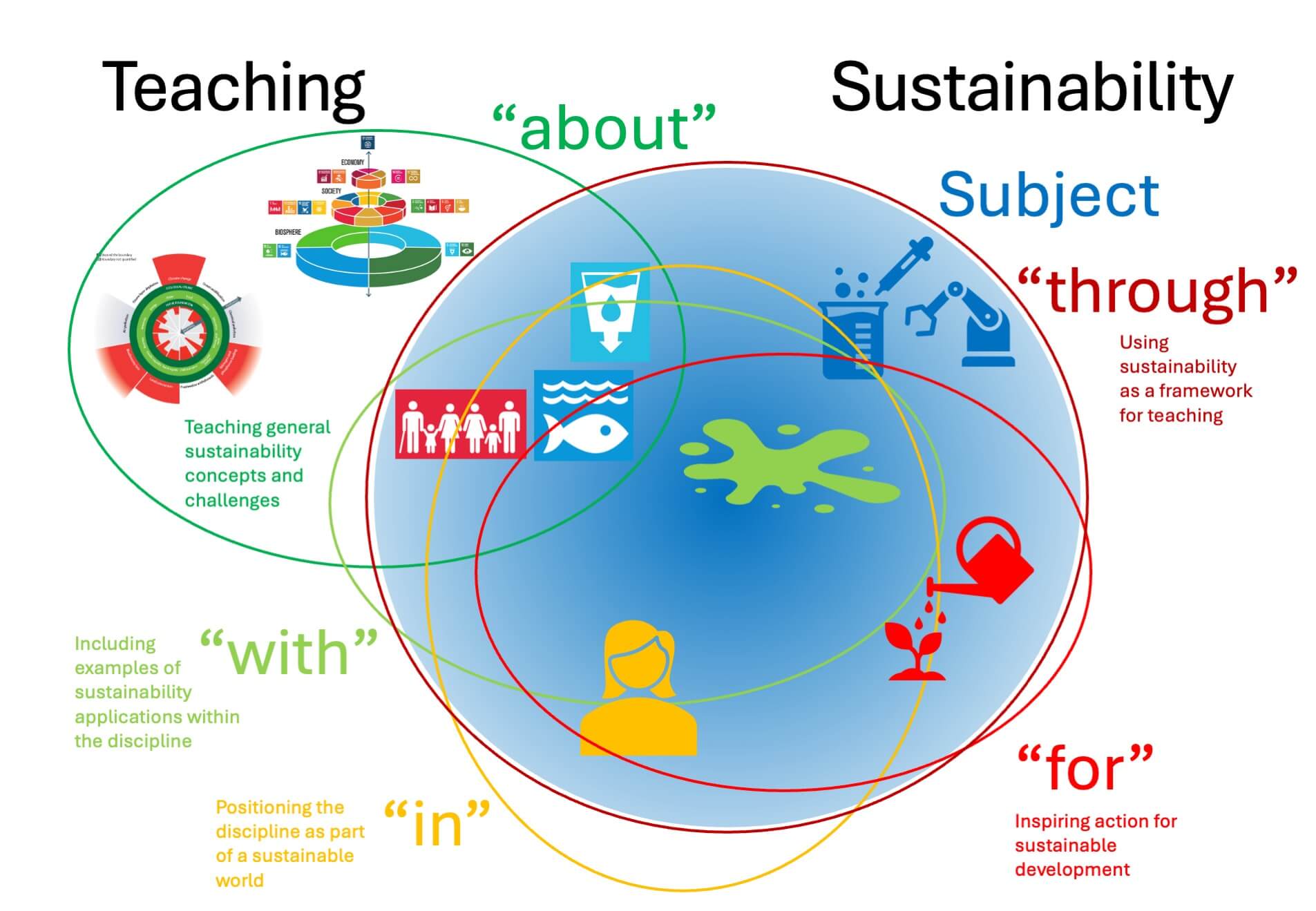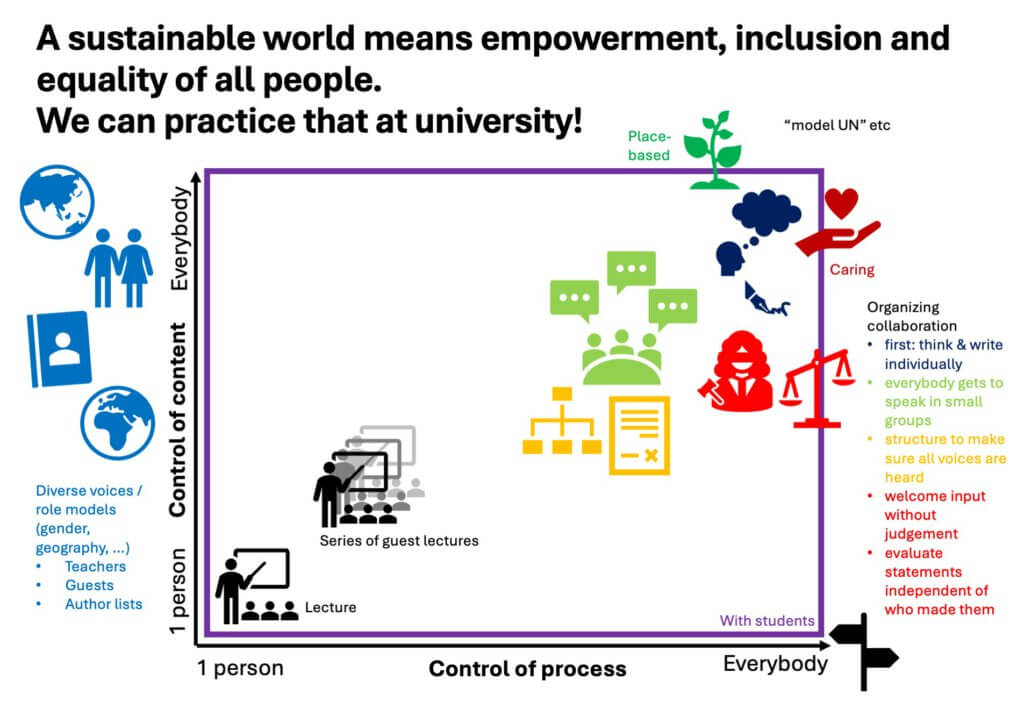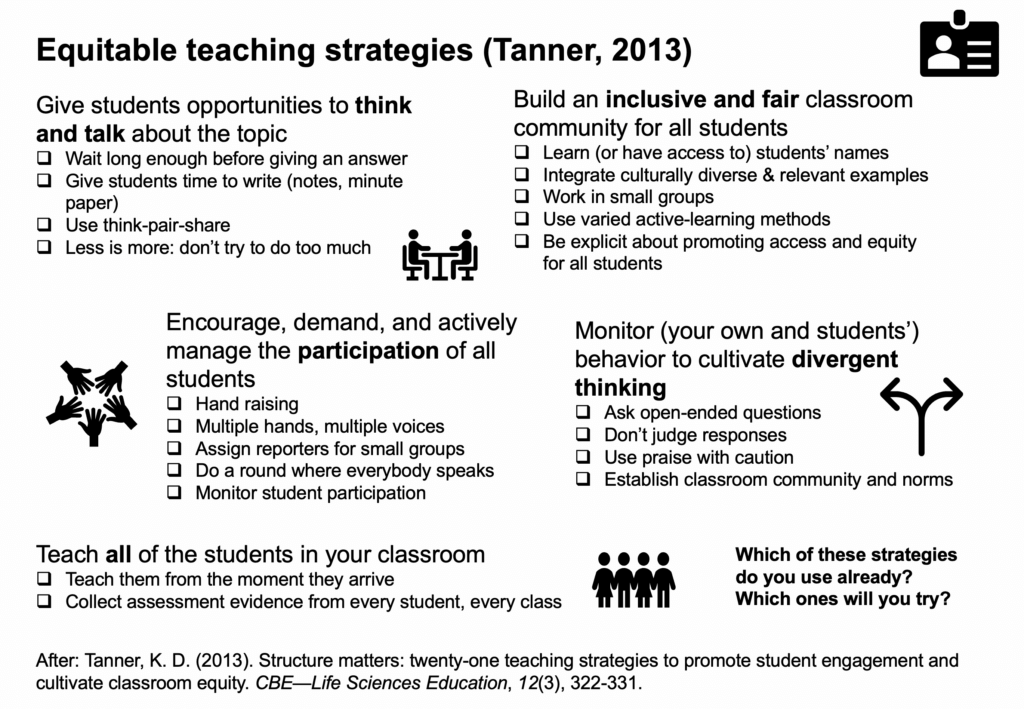
Teaching THROUGH Sustainability
I recently wrote about the framework of Teaching about, with, in, through, for Sustainability (which I had found in a bluesky post by Kyle Bartlett and then adapted to my own context and purpose). I have since used it in a lot of conversations and found it extremely useful to address different aspects of what teaching sustainability can mean. In a seminar today, I tested a different visualisation of the idea, and of how all these different approaches can be combined in one course where they complement what is going on there without necessarily taking up a huge amount of extra space.
So in a nutshell, in the figure above: Let’s imagine we are teaching a course where some technical food production process is discussed and optimised (the blue circle). That is what the course has always been about and what fits with the courses that build on it, into the available time, etc.. If we now think about teaching about sustainability (dark green in the picture above), that means teaching general sustainability concepts and challenges like for example planetary boundaries or SDGs. A lot of that might be outside of the scope of the course, and that’s ok. But maybe there are aspects that are relevant? Here visualised as the SDG “clean water”, which might be related and thus could be taken up in this context. If we now also want to teach with sustainability (light green in the picture above), including examples of sustainability applications within the discipline, we could imagine discussing what happens if something within the production process goes wrong, if there is for example a spill of toxic waste from the factory. This might now also influence another SDG, “life under water”, and we might discuss how placing a factory in certain regions in the world makes production cheap on the one hand, but on the other hand means that the laws and regulations are different so that workers might not be paid adequately or work way too long shifts. Now, the SDG “no poverty” might also become relevant, because one way of ensuring that spills are detected and acted upon quickly might be to make sure that working conditions are improved. Discussing this can then also be teaching in sustainability, positioning the discipline as part of a sustainable world, role-modelling and making it explicit that it is part of our professional identity and responsibility to care about sustainability and to consider the bigger picture. And then lastly teaching for sustainability would be inspiring action for sustainable development. What I have claimed, but what needed a bit more elaboration, is that we can also teach through sustainability, using sustainability as a framework for teaching. So that is what I tried today.
Here, my claim is that a sustainable world means empowerment, inclusion and equality of all people, and that we can, and should, practice that at university. The process is the point! Living together in a sustainable society isn’t something that we can switch on the day all the other problems are solved, it is part of solving the other problems, and we need to practice it and find out what it even means.
While there are of course big and awesome things we can do to practice, like the model UN or similarly large simulations, or big projects, my focus here is on everyday teaching situations and the small things we can do today to tweak them, so, in the image above, teaching everything in the blue area that we were going to teach anyway, just through sustainability. My new slide draft for that below.
In addition to making sure that we let students experience connection, with the world (for example through place-based pedagogies like the one described in “carving space”), with their community (through service learning), with each other (by making sure that they work in functioning teams), with a caring teacher (by making care for students and their learning explicit and explaining things that might be perceived as unnecessary barriers, like entry tickets to seminars, as part of care for student learning), there are lots of small strategies we can use. Many of those described in Tanner (2013) (see summary below), but all with the idea to give students control of the content and process of learning, while making sure that we create structures that facilitate equitable conditions for learning.
So those are my thoughts on teaching through sustainability so far. Other suggestions? I am really looking for feedback here, this is work in progress!


Currently reading Mårtensson et al. (2011) on "Developing a quality culture through the scholarship of teaching and learning" - Adventures in Oceanography and Teaching says:
[…] Departmental seminars. Those aren’t happening really regularly for all of LTH at the moment, but there are smaller work groups that meet regularly to discuss their teaching (for example, Terese and I have been invited to a group three times this spring to talk about teaching for (and especially through) sustainability. […]
Reading about a capstone project designed to integrate sustainability in software engineering - Adventures in Oceanography and Teaching says:
[…] So main take-away from this study for me? They did a very technical course and did a good job at using what people learn in that course and use it on sustainability applications, without any drastic “costs” in terms of learning on other areas (I’m assuming — otherwise they would surely have mentioned that). Their main lessons reflect nothing super surprising and also more related to the general setup of project work, and I would have loved to see a strong sustainability understanding in their requirements and thus their projects. But they do show that, and document how, it is possible to pivot a course to using sustainability examples and applications without changing the very technical ILOs. And it is nice to have this documented to also encourage other people to do something similar, a nice example of teaching with sustainability! […]
Currently reading Ferguson (2025) on "Norwegian higher education teachers’ beliefs about teaching, motivation, and approaches to researching and developing teaching" - Adventures in Oceanography and Teaching says:
[…] input through, for example, academic developers. Which is what we are working on, for example the seminar I gave today was an invited seminar to a regular group lunch meeting where they were looking for input on their […]